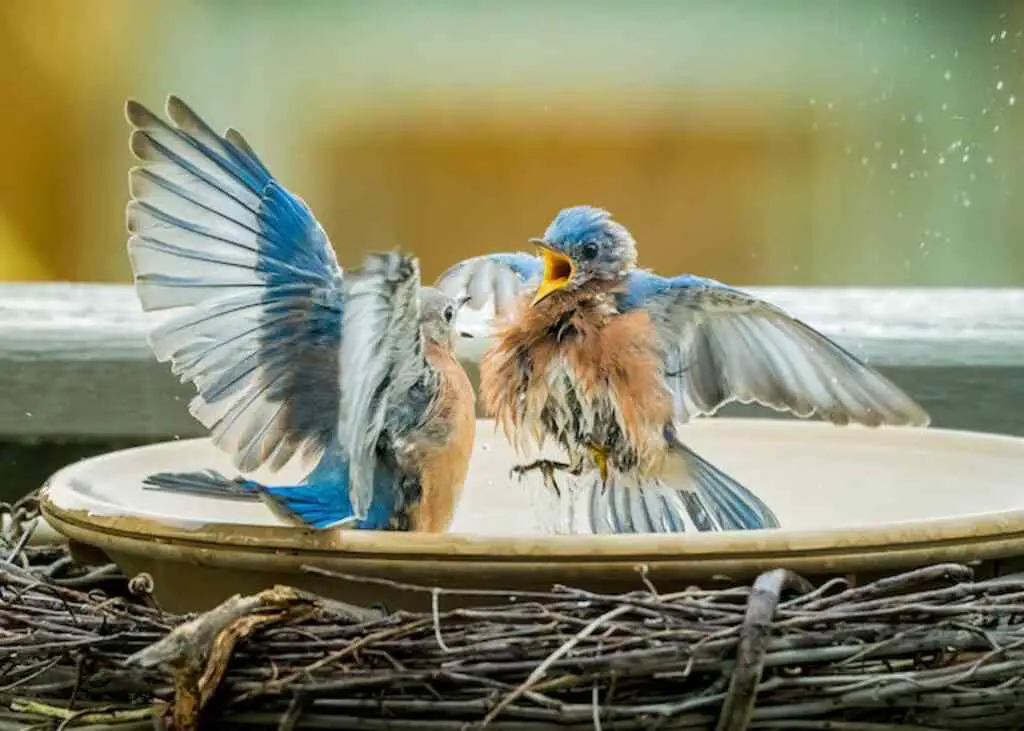Do Birds Bully Each Other? Find out the fascinating world of avian social dynamics as we delve into the intriguing phenomenon of bird bullying.
Discover why some feathered friends engage in assertive behavior, the factors that contribute to it, and how it shapes their interactions. Join us for a captivating exploration of avian behavior!
Table of Contents
- 1 Overview
- 2 Factors that Contribute
- 3 Types of Bully Birds
- 4 Behavior and Characteristics
- 5 Methods of Exclusion
- 6 Designing Feeder Solutions
- 7 Food Preferences of Bullies
- 8 Cleaning and Maintenance
- 9 Balancing the Needs of All Birds
- 10 Hummingbird Bullying
- 11 Understanding Bully Behavior
- 12 Encouraging Backyard Diversity
- 13 Frequently Asked Questions
- 13.1 Are all bird species capable of being bullies at bird feeders?
- 13.2 Can bully birds cause harm to other birds while feeding?
- 13.3 How do bully birds choose which feeder to target?
- 13.4 Is it possible to completely eliminate bully birds from a backyard bird feeder?
- 13.5 Can bird feeders be designed specifically to attract less aggressive bird species?
- 14 Conclusion
- 15 Author
Overview
The behavior of certain avian species towards other birds in feeding situations is characterized by aggression, territoriality, and competition, which can lead to the exclusion of certain species and a decrease in backyard bird diversity.
The causes of this behavior are varied and may include factors such as the natural aggression and territoriality of certain species, as well as the availability and quality of food sources.
Examples of bird species that are known to exhibit bullying behavior include larger, more aggressive birds such as blue jays and grackles, as well as highly social and flock-feeding birds like house sparrows and European starlings.
The impact of bird bullying on backyard bird diversity can be significant, as it can result in the exclusion of certain species from feeding areas and an overall decrease in the number and variety of birds that visit backyard feeders.
However, there are a number of prevention and management strategies that birders can employ to discourage bullying behavior and promote a more diverse bird population.
These strategies may include providing specialized food sources, eliminating perching areas for bully birds, and regularly cleaning feeding areas to reduce the attraction of bully birds.
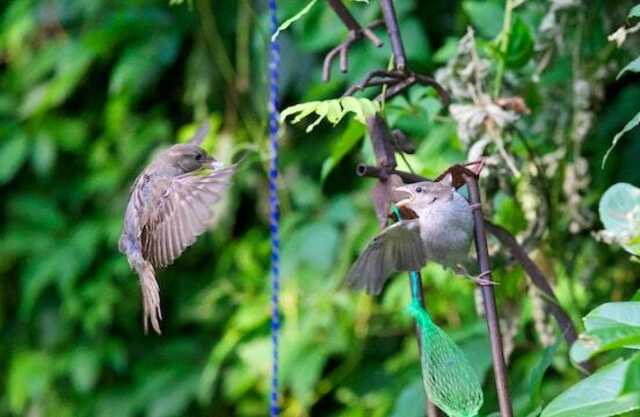
Factors that Contribute
Factors contributing to the aggressive behavior observed in bird feeding areas include the species’ social dynamics, territorial instincts, food caching behaviors, and attraction to inexpensive seed options.
Highly social bird species that flock feed are more likely to become bullies, as they can crowd out other birds and monopolize the food source.
In a similar vein, larger and more assertive bird species can often dominate feeding areas, displaying territorial behavior and acting as feeder bullies.
Certain bird species exhibit caching behavior, storing food in their crop or at feeders.
This unique habit allows them to spend more time feeding and consume a larger amount of food, limiting the resources accessible to other birds at the feeder.
Feeder placement can also contribute to aggressive behavior in bird feeding areas.
Removing perches from tube feeders, trays or nets that catch seed at the bottom of feeders, and changing suet feeder designs can effectively exclude bully birds.
Additionally, seeds scattered below feeders can be an open invitation for bully birds.
Attraction to inexpensive foods such as cracked corn, millet, milo, wheat, and sunflower seeds can also lead to bully bird behavior.
By understanding the root causes of bullying behavior in birds, enthusiasts can employ successful tactics to discourage it and foster a diverse bird population in their own backyard.
The subsequent section will discuss types of bully birds and how to identify them.
Types of Bully Birds
Identifying the different types of aggressive bird species that dominate feeding areas is crucial in understanding how to effectively manage and discourage their behavior.
Some of the more common bully species include Blue Jays, Grackles, Starlings, and House Sparrows.
These species are known for their aggressive behavior and territorial tendencies when it comes to feeding.
They may aggressively chase other birds away from the feeder or even physically attack them.
Identifying these species is important in developing strategies to manage their behavior and prevent them from dominating the feeding area.
Understanding the behavior and characteristics of different types of bully birds can have a significant impact on bird diversity.
When bully birds dominate a feeder, they can prevent other species from accessing the food, which can lead to a decrease in population numbers.
This is especially true for smaller birds that are not as aggressive and tend to avoid conflict.
By identifying and managing bully bird behavior, birders can help promote a more diverse and thriving bird population in their backyard.

Behavior and Characteristics
Understanding the behavior and characteristics of aggressive bird species can aid in developing effective strategies for managing their dominance and promoting a more diverse bird population in backyard feeding areas.
Social hierarchy plays a significant role in determining which birds become bullies, with highly social and flock feeding species more likely to dominate feeding areas.
Additionally, territorial disputes are common among bird species, and aggressive tendencies are more prevalent in larger birds, which can store food in their crop, spend more time at feeders, and take more food, leaving little for other birds.
To further understand the behavior of bully birds, here are some characteristics that can help identify them:
- Bully birds often feed in flocks, which can crowd out other species and prevent them from accessing the seed.
- Some bully birds will guard a feeder they perceive as theirs and attack or chase away any other birds that try to feed.
- Larger bully birds may cache food or store it in their crop, spending more time at feeders and taking more food, making it unavailable to other feeder birds.
- Smaller bully birds can be equally problematic, feeding in large flocks that can consume all the available seed and prevent other species from feeding.
Understanding these characteristics and behaviors can help in identifying bully birds and developing strategies to discourage their aggression and promote a more diverse bird population.
The subsequent section will discuss different methods of exclusion that can be used to discourage bully birds from dominating backyard feeding areas.
Methods of Exclusion
By implementing various methods of exclusion, backyard birders can promote a more diverse and peaceful feeding area for their feathered guests.
Preventative measures can be taken to discourage bully birds from taking over feeding stations.
These measures may include using wire mesh to enclose feeders, or weight-activated perch feeders to prevent larger bully birds or flocks of bullies from accessing the feeder.
Removing perches from tube feeders can also minimize how many bully birds can use the feeder.
Additionally, removing trays or nets that catch seed at the bottom of feeders will remove perching space for larger bullies. Changing the design of suet feeders can effectively exclude bully birds.
Deterrent strategies can be implemented by switching to more specialized foods such as safflower seeds for cardinals, Nyjer for finches, jelly for orioles, and fruits for songbirds.
Seeds scattered below feeders are an open invitation for bully birds, so regular cleaning of feeding areas and seed trays can remove excess seed and reduce the attraction of bully birds.
Providing an easy-feeding area for bully birds can help balance the needs of all your guests.
By taking these simple steps to discourage bully birds, it is possible to safely urge them to move along, and encourage backyard bird diversity.
In the subsequent section, we will discuss designing feeder solutions that can further prevent bully behavior.

Designing Feeder Solutions
Creating effective feeder solutions is crucial for maintaining a harmonious and diverse backyard bird community, while minimizing aggressive behavior among certain bird species.
Weight-activated perches are an excellent option for preventing larger bully birds or flocks of bullies from accessing the feeder.
These perches close off the feeding ports when the weight of a larger bird is on them, preventing them from monopolizing the feeder.
Similarly, wire mesh enclosures keep larger birds away from the feeding ports, allowing smaller birds to feed in peace.
Additionally, removing perches from tube feeders can minimize how many bully birds can use the feeder, as there are fewer spaces for them to perch and monopolize the seed.
Removing trays or nets that catch seed at the bottom of feeders will remove perching space for larger bullies, and changing the design of suet feeders can effectively exclude bully birds.
All of these solutions help maintain a peaceful feeder community, allowing all bird species to access the food and reducing aggressive behavior.
Food preferences of bullies are also an important consideration in designing effective feeder solutions. Birds with bullying behavior are often drawn to affordable food options, including cracked corn, millet, milo, wheat, and sunflower seeds.
By transitioning to specialized foods like safflower seeds for cardinals, Nyjer for finches, jelly for orioles, and fruits for songbirds, you can offer a diverse and plentiful buffet while discouraging feeder-hogging bullies from depleting the feeders.
To prevent bully birds, it’s crucial to regularly clean the feeding areas and seed trays beneath the feeders. By removing excess seed and reducing the appeal to bully birds, you can maintain a harmonious feeding environment and discourage unwanted behavior.
Providing an easy-feeding area for bully birds can help balance the needs of all your guests.
By designing effective feeder solutions that cater to the food preferences and behaviors of different bird species, it is possible to discourage bully birds and maintain a diverse and harmonious backyard bird community.
Food Preferences of Bullies
Bully bird diets play a significant role in their behavior at feeders. Many of these species are attracted to inexpensive foods, such as cracked corn, millet, milo, wheat, and sunflower seeds.
These foods are high in calories and provide a quick energy source for birds, which is why bully species are drawn to them.
However, feeder menu planning can also be used as a technique to exclude bully birds.
By offering specific food types tailored to different bird species, like safflower seeds for cardinals, Nyjer for finches, jelly for orioles, and fruits for songbirds, you can create a diverse and abundant buffet while deterring feeder domination by bullies.
Food-based exclusion techniques can also be used to discourage bully birds.
For example, seeds scattered below feeders can be an open invitation for bully birds, so removing them can help to reduce the attraction of bullies.
In addition, maintaining cleanliness in feeding areas and seed trays helps eliminate excess seed and minimize the likelihood of attracting dominant birds.
By making small changes to the feeding area and menu planning, birders can create a more balanced environment for all bird species to enjoy.
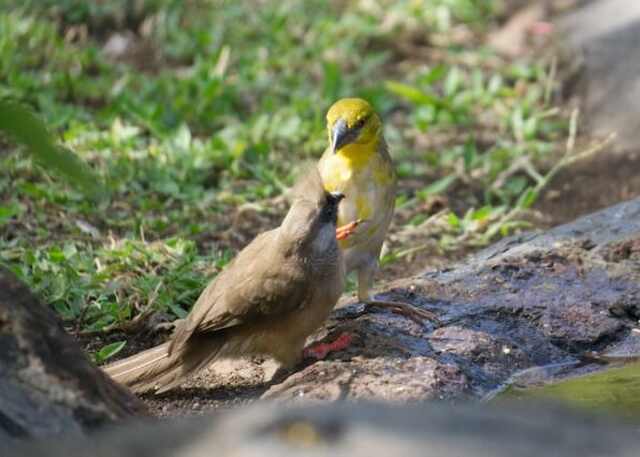
Cleaning and Maintenance
Regular cleaning and maintenance of feeding areas and seed trays is essential to prevent aggressive birds from dominating feeders.
Cleaning frequency and sanitation practices are important to ensure that excess seed, droppings, and mold do not accumulate in the feeding area, which can attract pests and diseases that can harm birds.
Additionally, pests such as squirrels and raccoons can become attracted to dirty feeding areas, which may lead to damage to the feeder or a decrease in bird activity.
Therefore, it is recommended to clean feeders and seed trays at least once a week with a solution of 10% bleach and water to ensure optimal hygiene and prevent the attraction of unwanted visitors.
In addition to regular cleaning, it is important to take steps to prevent aggressive birds from dominating feeders.
Providing an easy-feeding area for bully birds can help balance the needs of all your guests.
This can be done by placing a separate feeder or providing a feeding area away from other feeders where bully birds can feed without disrupting other birds.
Additionally, offering a variety of specialized foods that are less attractive to bully birds, such as safflower seeds, Nyjer, jelly, and fruits, can help to reduce competition and increase diversity in the feeding area.
By implementing these strategies, birders can create a welcoming and safe environment for all birds to enjoy.
Balancing the Needs of All Birds
Maintaining a harmonious feeding environment for a diverse range of avian species requires a strategic approach to food provision that effectively caters to the unique feeding behaviors and preferences of various bird species without encouraging aggressive behavior or monopolization of the feeding area.
Feeder management is key to creating a welcoming environment for all birds.
Providing multiple feeders with different types of foods can help to spread out the feeding activity and reduce crowding, which can be a trigger for aggressive behavior.
Additionally, bird-friendly gardening can provide natural food sources for birds, which can help to reduce their reliance on feeders and create a more balanced environment.
Creating bird habitats with nesting boxes, water sources, and shelter can also encourage a diverse range of bird species to visit the area.
While it is important to provide for the needs of all birds, it is also important to recognize that some birds may exhibit aggressive behavior.
For example, hummingbirds can become territorial and aggressive toward each other, which can limit the feeding opportunities for other birds.
By implementing strategies to discourage hummingbird aggression, such as offering multiple feeders with spaced-out feeding ports or using vibrant feeders to divert and attract hummingbirds, you can prevent these petite birds from becoming overpowering bullies.
By creating a balanced feeding environment that caters to the needs of all birds, birders can enjoy a diverse range of feathered visitors without worrying about aggressive behavior and monopolization of the feeding area.
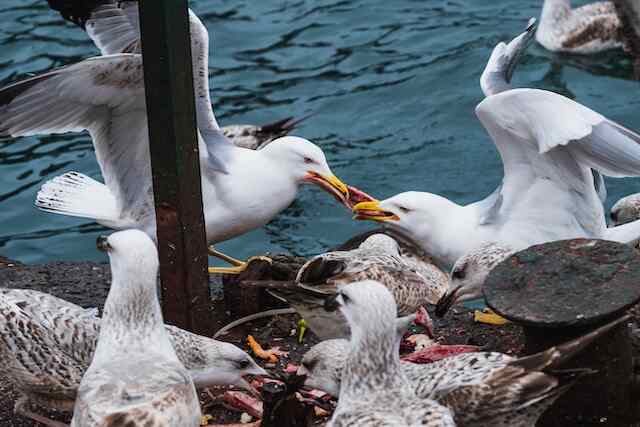
Hummingbird Bullying
Hummingbird aggression can severely limit the feeding opportunities for a diverse range of bird species and can even monopolize the entire feeding area.
Hummingbirds are known for their territorial aggression, which can become problematic for other bird species when they start to dominate bird feeders.
Ensuring harmonious coexistence among various bird species is essential in mitigating hummingbird bullying and effectively managing territorial aggression. Here are some measures that can be taken to prevent hummingbird bullying:
- Providing multiple feeders: Setting up multiple feeders in different areas can help prevent hummingbirds from monopolizing one feeding area. This allows other bird species to access the food without being intimidated by the aggressive behavior of hummingbirds.
- Spacing feeders out: Placing feeders at a distance from each other can help reduce territorial aggression, as hummingbirds may view these areas as separate territories.
- Offering different types of food: Hummingbirds may prefer nectar-based food, but they are also attracted to insects and fruit. Providing a variety of food options can encourage hummingbirds to explore other areas instead of dominating one feeder.
- Using feeders with perches: Hummingbirds often use their wings to hover while feeding, making it difficult for other birds to access the feeder. Using feeders with perches can allow other bird species to access the food more easily.
- Providing multiple feeding stations: Setting up multiple feeding stations throughout the yard can help reduce the number of birds competing for food in one area.
Promoting peaceful coexistence among different bird species requires a thorough understanding of bullying behavior and its consequences.
By implementing measures to prevent hummingbird bullying and effectively managing territorial aggression, bird enthusiasts can foster a harmonious feeding environment that supports the thriving presence and appreciation of a diverse range of bird species.
Understanding Bully Behavior
Understanding the behavior of dominant bird species is crucial in creating a harmonious feeding environment for a diverse range of avian visitors.
Bullying behavior among birds is a result of inherent instincts driven by resource competition, including food and nesting sites.
The most common bully birds are highly social and flock feeding species, as they are more likely to compete for food and territory.
Larger and more aggressive species can also become bullies, as they are capable of storing food in their crop, which leads to them spending more time at feeders and taking more food that is not available to other birds.
Solutions for preventing bully behavior in birds include providing multiple feeding areas to reduce competition for resources.
For example, birders can set up several feeders in different locations or use different types of feeders to accommodate different species.
Additionally, birders can switch to more specialized foods that are less attractive to bully birds, such as safflower seeds for cardinals or jelly for orioles.
Regular cleaning of feeding areas and seed trays can also help reduce the attraction of bully birds.
Understanding the causes and solutions of bullying behavior in birds is crucial for fostering a safe and harmonious feeding environment that promotes diversity in your backyard.

Encouraging Backyard Diversity
Promoting variety in avian visitors can be positively fostered by implementing effective strategies to mitigate the dominance of certain bird species.
Creating a diverse habitat for birds is the first step towards encouraging a variety of species to visit. Planting a variety of flowers, shrubs, and trees that produce fruits and seeds throughout the year can attract different bird species.
Providing different types of feeders that cater to specific bird species can also help to attract new visitors.
For example, offering nectar feeders for hummingbirds or mealworms for bluebirds can bring in a variety of species that may not typically visit a traditional seed feeder.
In addition to creating a diverse habitat, it is important to take steps to discourage bully birds. Bully birds can take over a feeder and prevent other bird species from feeding.
Removing perches from tube feeders, using weight-activated perch feeders, and changing the design of suet feeders can effectively exclude larger bully birds.
Switching to more specialized foods can also discourage bully birds from emptying feeders.
By encouraging diversity and discouraging bullying behavior, bird enthusiasts can promote a variety of bird species in their backyard, creating an enjoyable environment for all.
Frequently Asked Questions
Are all bird species capable of being bullies at bird feeders?
Dominant behavior and social hierarchies are common among bird species, and these dynamics can play out at bird feeders.
Although not all bird species engage in bullying behavior, certain factors can contribute to dominance and aggression among highly social and flock-feeding species, as well as larger and more assertive species, especially in feeder environments.
Bully birds are naturally more territorial about their feeding areas and may guard a feeder they perceive as theirs, attacking or chasing away any other birds that try to feed.
Feeder dynamics can also play a role in bully behavior, as larger bully species may cache or store food in their crop, spending more time at feeders and taking more food, leaving less for other feeder birds.
However, by taking steps to discourage bully behavior, such as using weight-activated perch feeders or switching to more specialized foods, it is possible to create a more balanced feeding environment for all bird species.
Can bully birds cause harm to other birds while feeding?
Feeding dynamics in bird communities can be complex, with social hierarchy and aggression patterns playing a significant role in determining who gets to feed and how much.
Bully birds, which are naturally more aggressive and territorial, can cause harm to other birds while feeding.
Certain dominant bird species have a tendency to hoard or stash food in their crop, resulting in prolonged time spent at the feeder and limited food resources for other birds.
Smaller bully birds often feed in flocks, which can crowd out other bird species.
Certain aggressive birds may exhibit territorial behavior around feeders, defending their perceived ownership and aggressively repelling other birds attempting to feed.
Therefore, it is important for birders to take steps to discourage bully birds from monopolizing feeders and creating an imbalanced feeding environment.
How do bully birds choose which feeder to target?
Bully birds choose which feeder to target based on a combination of feeder placement, dominance behaviors, and food availability.
Feeder placement plays a crucial role in determining which birds have access to the feeder and which do not. For example, feeders placed in open areas with no nearby cover are more likely to be dominated by aggressive species.
Dominance behaviors and pecking orders among birds also play a role in determining which birds have access to the feeder. Typically, larger, more aggressive species will dominate smaller, less aggressive species.
Lastly, food availability is a key factor in determining which feeder a bully bird will target. Feeder birds are naturally territorial about their feeding areas and will defend their food source from other birds.
Bully birds may also cache or store food in their crop, which can lead to them spending more time at feeders and taking more food, leaving less for other species.
Is it possible to completely eliminate bully birds from a backyard bird feeder?
Eliminating bully birds from a backyard bird feeder is a challenging task. It requires a combination of different strategies that discourage their behavior without harming them.
One way to discourage bully birds is to change the placement of the feeder. By placing it in a more open area, birds are less likely to feel territorial and aggressive towards each other.
Another strategy is to offer specialized food that is not as attractive to bully birds, such as safflower seeds, Nyjer for finches, jelly for orioles, and fruits for songbirds.
It is also recommended to change the time of day when feeding the birds, as some bully species are more active during certain hours.
However, it is important to note that completely eliminating bully birds is unlikely as they are a natural part of the ecosystem. Instead, birders should aim to create a balanced environment that allows all bird species to thrive.
Can bird feeders be designed specifically to attract less aggressive bird species?
Modified bird feeders can be designed to attract non-aggressive bird species and modify feeding behavior.
By eliminating perches from tube feeders, larger bully birds can be prevented from accessing the feeder.
Weight-activated perch feeders can also prevent larger bully bird species or flocks of bullies from accessing the feeder.
Enclosed bird feeders in wire mesh can keep larger birds away from the feeding ports.
Changing the design of suet feeders can effectively exclude bully birds.
Furthermore, using specialized foods such as safflower seeds for cardinals, Nyjer for finches, jelly for orioles, and fruits for songbirds can still provide a bountiful buffet without encouraging bullies to empty every feeder.
By modifying bird feeder designs and food selection, it is possible to attract less aggressive bird species and discourage bully birds.
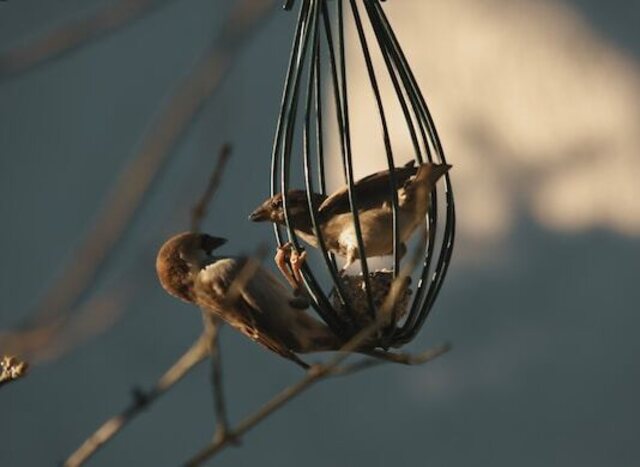
Conclusion
In conclusion, while bird feeders can be a great way to attract a variety of species to one’s backyard, the behavior of bully birds can be a problem for bird enthusiasts looking to encourage backyard bird diversity.
Understanding the factors that contribute to bully behavior, the types of birds most likely to exhibit this behavior, and methods of exclusion can help birders discourage poor behavior and reserve feeders for more species to use.
However, it is important to balance the needs of all birds, as even the most persistent bully bird plays a role in the ecosystem.
One rhetorical literary device that can add depth to this discussion is metaphor.
Comparing the behavior of bully birds to that of a schoolyard bully can help readers understand the negative impact this behavior can have on other birds and the importance of taking steps to discourage it.
Just as a schoolyard bully can monopolize the playground and prevent other children from playing, bully birds can monopolize bird feeders and prevent other species from accessing food.
By using metaphorical language to describe this behavior, readers are better able to understand the need for action.

